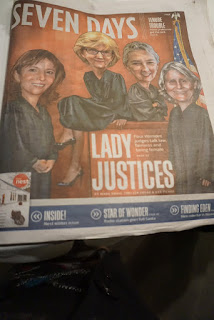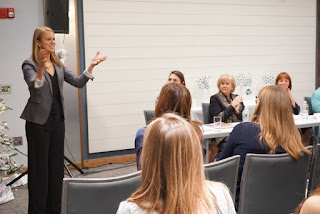With the stage set by this week’s cover
story in Seven Days, the VBA Women’s Division hosted its panel discussion
Wednesday night featuring Judge Christina Reiss, Justices Marilyn Skoglund and
Beth Robinson and Judge Helen Toor. With
the theme being the importance of having women in positions of authority, the
Women’s Division capped off 2018, the Year of the Woman, with this enlightening
and engaging event. Like the Seven Days
article, much of the focus was delving into the paths that each of these successful
women took to end up where they are today. Approximately 100 attendees enjoyed
the panel presentation by the judges and justices, with time for some Q&A
at the tail end of the program.
Perhaps not surprisingly, none of the judges had life
plans that involved becoming a judge.
Judge Reiss, when asked how she went from being a French major to
becoming the first female Article III Judge in Vermont, noted that she got
through every challenge by just saying, “why not me?” Justice Skoglund, who majored in sculpture,
credits her success to just working hard. When the opportunity to become a
judge came to her, she initially declined, saying that she just couldn’t do
that to her kids, but when she approached her kids with the news, they all
encouraged her to do so, saying, yes you can! She noted that having Denise
Johnson on the Court already was inspiring, especially seeing working female lawyers
and judges with kids. She noted that one
of her biggest inspirations was Janis Joplin, just because she was courageous
and didn’t care what other people thought.
Judge Toor worked at a Ben & Jerry’s scoop shop
between college and law school.
Environmental law inspired her, as well as her desire to leave New York
and come back to Vermont. Surrounded by
male judges in federal court in New York, it was when a 44-year old woman was
appointed to the federal bench that she suddenly was able to picture herself in
that role. When Justice Robinson was
appointed to the Vermont Supreme Court, without prior judicial experience, she
recalls a friend reminding her that she had plenty
of experience being on the bench in Indiana, for high school basketball! She
always thought she wanted to be a teacher, but it was during her senior year in
college that she decided to go to law school.
Justice Robinson loved the intellectual challenge and loved the work she
ultimately did at Langrock, Sperry & Wool.
On the path to judgeship, Justice Robinson counsels folks
to realize that there is a huge element of a “crap shoot.” Because your planned path may not happen, she
advises that you take steps for their own sake--to pursue what you are most
passionate about and do it well. Justice
Robinson’s involvement in the Baker
(civil union) case was never considered a step or path to judgeship, just something
she was passionate about and was compelled to do well.
All of the judges remarked some about the joys and
challenges of being a judge. Judge Toor
noted how shocked she has been by the scope of poverty and drug abuse in the
state. But she said she also enjoys
learning about so many fascinating facets of life, like really learning about
milking machines or bridge supports from people who live and love those
things. Most of the judges remarked that
being a judge is fairly isolating, at times, but noted that their families and
non-lawyer friends keep them from being too lonely. While they all have judicial colleagues to
bounce ideas off of, most remarked that they were surprised how little that
happens compared to the time spent researching and drafting alone.
When asked what advice they would give to younger
attorneys, Judge Toor realized how much being a judge necessitates that you
stop worrying what other people think of you.
Her advice would be to start now and not worry about what others
think. Judge Reiss wants young female lawyers
to realize their high value to their firms, in marketing, in quality work, in
diversity, and to be confident enough to not stress over having to leave early to
pick up kids or request an alternate schedule. She also reminded the attendees that court
advocacy is communicating, finding the best advocates to be conversational and
comfortable rather than confrontational. Justice Skoglund counseled to always
work hard and be prepared for cases. Justice Robinson and Judge Toor, garnering
nods from all the judges, stressed that being courteous to your opponent, both
in court and in writing, is one of the most important factors in good advocacy.
When questions arose about sexism in the judiciary or in the
legal profession, generally, most of the judges noted that they have not
experienced much on the bench. When
reacting to a quoted study that showed that women judges are interrupted more
and have their names mixed up more than their male counterparts, Justice
Skoglund did laugh, noting that she is called Justice Johnson all the
time! Judge Toor noted that she’s had
pro se litigants inappropriately say she was beautiful during hearings, but that
the attorneys have all treated her with respect on the bench.
Regarding sexism, the judges were optimistic that most of
the egregious behavior they’ve experienced is in the past, perhaps by virtue of
being on the bench or perhaps because times have changed. Not wanting to dredge up too many old
memories, Justice Skoglund just gave one example of when a male attorney,
rather than complimenting her on her excellent advocacy at a hearing, asked her
why she wasn’t wearing heels (she was 8 months pregnant!). Judge Toor recalled being asked to get coffee
many times. And Justice Robinson recounted a story where she was second chair
on a big case, with multiple depositions, and when showing up for another
deposition, on time, with her large bag, she sat waiting for quite a while
before the other lawyer remarked that he guessed the other lawyer wasn’t going
to show up. He assumed she was the court
reporter. Justice Robinson did note that
she owes much of being in her position at the Court, being granted equal
respect, and even being allowed to wear pants, to the trailblazers who came
before her.
The audience did ask about implicit bias training, and
the judges remarked about how they’ve taken some of the tests and received some
training. Just having the conversation
raises awareness, as does having diversity around you, as Justice Robinson
noted. Overall, the presentation was extremely optimistic and inspiring. While we often speak of the aging bar in
Vermont, and nationally, the room was full of youth and energy, as so many
young attorneys soaked in the real and down-to-earth perspectives of these
truly inspirational women in powerful positions.
Before closing and heading into the cocktail reception, VBA
President-Elect, Beth Novotny, made a pitch for the next installment of our
implicit bias CLE series, to be a plenary session at our Mid-Year meeting in
March. The general implicit bias overview
at our Annual Meeting received our highest remarks and compliments. Not only do we intend to continue the
implicit bias training at our meetings, the Women’s Division was inspired by
this event to host more panel discussions in the future. Also, in the Spring, please watch your
inboxes for an important gender survey from the VBA, similar to what is being
done in other states. We want to keep
the conversation (and the comradery) going!
Special thanks to the VBA Women's Division officers and representative, Samantha Lednicky, Alison Milbury Stone, Erin Gallivan and Judith Dillon, for all their hard work in putting the event together and to the generous sponsors who helped make this event possible: Vermont Bar Association, Downs Rachlin Martin PLLC; Lisman Leckerling, PC; Mary Kehoe Law; Barber & Waxman; Rich Cassidy Law; Langrock, Sperry & Wool; Sheehey Furlong & Behm; Murdoch, Hughes, Twarog & Tarnelli, PC and Elizabeth Novotny.
Please enjoy the following pictures and smiling faces from the event.
















































